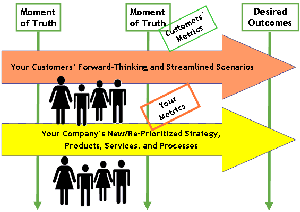When and How to Embed Customer Co-Design into Your Projects
What Customer Co-Design Options Fit Your Purview?
We have found at least six opportunities to embed customer co-design into the projects you’re already doing. These opportunities can vary by role. We provide tips on how best to take advantage of customer co-design to successfully create a customer-centric culture.
NETTING IT OUT
Business and consumer customers are happy to co-design improved solutions with your team. Customers like being listened to and taken seriously. They enjoy helping you come up with new ideas and approaches. Customers are happy to provide valuable context that will help you make your new solutions successful faster.
There are at least six opportunities we’ve found to embed customer co-design into the projects you’re already doing. Which of these opportunities make the most sense for you will depend on your role in your organization. You can only embed customer co-design into initiatives where you’re in charge and you can allocate resources. As you’ll see, customer co-design can take many forms.
The bottom line: Use customer co-design early and often.
Co-Design with Your Customers
© 2012 Patricia Seybold Group
WHEN IS CUSTOMER CO-DESIGN APPROPRIATE?
When You Want to Succeed with Customers
It’s certainly possible to design experiences, systems, processes, and products without involving the intended users of those solutions. In fact, a great many products, web sites, mobile apps, and experiences are designed first by creative individuals or teams. These solutions are then rolled out and piloted with their intended audiences. End-customers provide useful feedback. The designs are then refined. But why would you want to invest your scarce resources in designing something that may miss the mark? Why not take advantage of customers’ willingness to contribute their ideas? Why not engage with your firm in order to ensure rapid adoption and a faster path to profitability?
How Will Your Firm Benefit from Customer Co-Design?
Co-designing with customers is mutually beneficial. Customers feel valued and understood. They help you design solutions that work well for them. The result: rapid uptake of new offerings and greater customer loyalty and evangelism. By working side by side with customers, the people in your organization gain valuable insights into customers’ needs and context. By acting on those insights, your team gains faster adoption of new products, services, or processes, and increased ROI.
Embed Customer Co-Design in Your Culture
The most customer-centric organizations practice many types of customer co-design. The ideas for new products or services often come from the members of their Customer Advisory Boards. The customers who participate in online self-service communities also recommend and vote on new capabilities or enhancements. In customer-centric firms, everyone monitors customers’ discussions in online communities. The many executives who eavesdrop on these customer discussions often spot new needs before they’re fully articulated.
When customer-centric companies do internal business process redesign and IT projects, they get customers engaged. They kick off their internal projects with customer co-design. That way, they can streamline both the customers’ processes and their own processes simultaneously.
Customers are intimately involved in the design of any customer-touching experience: shopping online and offline, new web sites or mobile apps, new business forms or invoices, improved processes for returns-handling or credit approval.
Product developers wouldn’t think of designing a new product or service without customer input from the outset and without customers involved at every phase of design. These firms’ user experience professionals observe how customers do things today in order to understand customers’ context deeply. User experience designers engage customers in usability testing as they refine the designs of any new or improved products and/or services.
Six Key Opportunities to Engage with Customers
Over the past thirty years, we’ve learned that there are particularly opportune times to reach out to customers (or to prospects). Here are the six opportunities that many firms use to engage with customers proactively:
- Benefit from customer advisory boards (CABs)
- Embed voice of the customer (VOC) into the firm’s culture
- Co-design a unique branded customer experience
- Streamline customer-impacting processes
- Co-develop new or improved products or services
- Profit from customer ecosystems
Benefit from Customer Advisory Boards. CABs become part of your business strategy co-design if you recruit your most insightful customers. Get customers working together with your top execs to address your thorniest business issues. Have these insightful customers identify and scope their most critical unmet needs.1 Circle back with them regularly to show them how their insights are shaping your strategy and to get them involved in piloting new solutions.
One of the most effective approaches we’ve seen for combining Customer Advisory Boards with customer co-design was an initiative in 2010-2012 by a large industrial manufacturer’s North American services group. A start-up business unit that was developing new services recruited insightful operational executives from a representative set of client companies to act as advisors. Through interviews and CAB meetings, these customer executives agreed upon priorities that would improve their own operations. Once the priorities were agreed upon, the customer executives also appointed their own subject matter experts (SMEs) to participate on innovation teams for an 18-month period. These supplier/customer innovation teams ...
***ENDNOTE***
1) For more information about how to run Customer Advisory Boards that deliver results for both you and your customers, see: "Creating Customer Advisory Boards that Your Customers Will Love! How to Design a Successful 'Outside In' CAB Program for Your Customers and Top Executives," by Patricia B. Seybold, September 13, 2007.
***ENDNOTE***
Sign in to download the full article
0 comments
Be the first one to comment.




